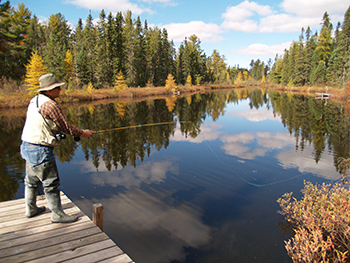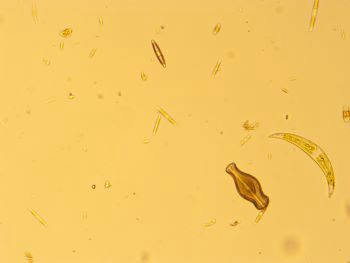Small snail, big problem: Researchers track invasive New Zealand mudsnail in Michigan rivers

New video illustrates key identification points of this invaderA tiny invader is threatening prized trout streams in Michigan’s northern Lower Peninsula. A mere 1/8-inch long, the New Zealand mudsnail is barely distinguishable from a grain of sand, but over time its invasive habits can affect the quality and quantity of trout and other fish in the Au Sable, Pere Marquette and Boardman rivers where it has been found.New Zealand mudsnails were first discovered in the United States in Idaho’s Snake River in 1987. Since then, infestations have spread throughout the western states and into areas of the Great Lakes. The discovery of New Zealand mudsnails in the Pere Marquette River in August 2015 signaled the first detection in a Michigan inland waterway. Within the next year, populations were confirmed in the Boardman and Au Sable rivers. The U.S. Geological Survey has developed an animated map illustrating the New Zealand mudsnail’s movement through the states.What harm can a snail do?
This brown to black mudsnail, a native of New Zealand, is considered invasive and is prohibited in Michigan due to the environmental harm it can cause to rivers, streams and lakes. Because the snail reproduces by cloning (females a close-up view of the New Zealand mudsnaildevelop complete embryos without fertilization), just one snail can start a population.
One snail can produce over 200 young in a year. Since no natural predators or parasites exist in North America, exponential population growth occurs unchecked, year after year. In some locations in western states, researchers have documented snails reaching densities of 300,000 per square meter. With that many mudsnails, food for other stream invertebrate populations can become scarce.
Fish that feed on native invertebrates like mayflies and caddisflies may find it more difficult to forage. In fact, Seth Herbst, the aquatic invasive species coordinator for the Michigan Department of Natural Resources Fisheries Division, said that fish will consume New Zealand mudsnails, but due to the snail’s thick shell and a tightly closing “hatch” called the operculum, they offer the fish no nutritional value and actually are commonly indigestible by trout and excreted alive. “In addition,” Herbst said, “substituting mudsnails for native food sources can reduce the growth and condition and ultimately the abundance of key sport fish including trout.”
What is Michigan doing to combat the problem?
Once New Zealand mudsnails were positively identified in the Pere Marquette River, the DNR and the Department of Environmental Quality began surveying heavily utilized rivers across the state. Since the discoveries in the Boardman and Au Sable rivers, no new mudsnail locations have been identified. Surveying efforts will continue through the 2017 field season.
Mudsnail distribution
In a project supported by the Great Lakes Restoration Initiative, the DNR and Michigan State University are working together to understand how widely distributed New Zealand mudsnails are in the Pere Marquette River and how these invaders may be affecting native invertebrates.
“We are also taking the opportunity to talk to anglers about their behaviors, whether they travel to multiple fishing spots in a single day, and whether they are washing their gear between visits,” said Dr. Dan Hayes, a professor and associate chair of MSU’s Department of Fisheries and Wildlife. “Their responses help us understand potential vectors for New Zealand mudsnail transportation.”
A chemical treatment targeting sea lamprey in the Pere Marquette River is scheduled for summer 2017. MSU researchers will use this opportunity to determine what, if any, effect the lampricide treatment has on mudsnails.
Citizen science
With support from the Michigan Invasive Species Grant Program, a group of citizen scientists soon will be involved in monitoring for New Zealand mudsnails in the Au Sable and other popular fly-fishing destinations. A partnership between Oakland University, Grand Valley State University, Michigan Trout Unlimited and Anglers of the Au Sable will provide training in mudsnail monitoring and sampling techniques to volunteers from the angling organizations.
Trained volunteers will take to the Au Sable River later this year and will branch out to other popular fly-fishing locations in the next two years to take water samples for environmental DNA testing, collect invertebrate samples from riffles, and spread the word to other anglers about the importance of cleaning gear and boats to prevent the spread of New Zealand mudsnails.
“Local anglers are familiar with invertebrate communities, they are frequently on the water, and they are familiar with their home waters,” said Dr. Scott Tiegs, an associate professor in the Department of Biological Sciences at Oakland University.
Tiegs, who is leading the citizen science project, also will spend time with all 20 chapters of Michigan Trout Unlimited to share techniques for ensuring that mudsnails are not accidentally transferred from stream to stream.
What can you do?
Invasive species management begins with prevention. Though the snails have been found in three river systems, it is not too late to prevent their spread to other rivers and lakes. Since it takes only one New Zealand mudsnail to start a population, prevention requires everyone’s involvement.
The most important means of prevention is practicing good recreational hygiene. After a visit to one of Michigan’s lakes, rivers or streams, be sure to clean, drain and dry your boat, trailer and gear before heading to a new destination.
The New Zealand mudsnail’s small size requires careful examination and cleaning of places where plants, sand or debris can be found on poles, nets, waders, boots, buckets, kayaks, canoes and flotation devices. Anything that has been in the water or at the water’s edge should be inspected before it is packed or loaded.
New video illustrates key identification points
MDEQ New Zealand mudsnail video still play buttonThe Department of Environmental Quality recently released a new video providing an overview of New Zealand mudsnail identification. The video is the premiere in the “MDEQ Minute” series, offering 60-second views on a broad range of topics including new and potential invasive species in Michigan.
If you think you have found a New Zealand mudsnail in a waterway outside of the Pere Marquette, Boardman or Au Sable rivers, report your finding using the Midwest Invasive Species Information Network website, www.misin.msu.edu, or download the MISIN app to your smartphone.
Contact: Seth Herbst, 517-284-5841 or Joanne Foreman, 517-284-5814





